Prime = Toyota’s Fuel Economy King
Toyota has had four Prius models since 2012, and last year (2016) sales of the Prius Liftback, Prius c, Prius V and Plug-in Prius added up to more than 136,000 units. Something new showed up at the end of the year that Toyota hopes will counter several years of declining cumulative Prius sales–the all-new 2017 Prius Prime. So what’s all the hoopla about because, isn’t one Prius the same another? Not so fast lumping the Prius Prime in with its siblings as it goes further, charges faster and looks way different than the others.
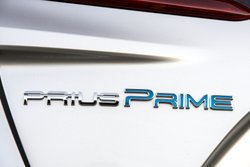
Clean Fleet Report spent a fuel-sipping week driving throughout Southern California in the 2017 Prius Prime Premium. With an eye on Toyota’s very appealing fuel economy claims, we wondered if it was possible to get 50+ mpg. Cutting to the answer, we did, and in a big way.
The front-wheel drive 2017 Prius Prime is powered by what Toyota says is its “most efficient hybrid powertrain,†which is where the car’s “Prime†name comes from—as in the best. Toyota considers this to be the most technologically advanced Prius it had ever made, going back more than two decades.
Prime Drivetrain
Toyota has mastered the parallel hybrid drivetrain, or Hybrid Synergy Drive as they brand it. The electric motor can power the car by itself, the gas engine can power the car by itself or they can power the car together, usually at the discretion of the car’s efficiency-focused computer. But the Prime offers one more power option—the car can go about 25 miles, and as fast as 84 mph, in pure EV mode.
The Hybrid Synergy Drive system comprises a 1.8-liter double overhead cam (DOHC), four-cylinder gasoline engine and two electric motors producing a net 121 horsepower through the Continuously Variable Transmission (CVT). The EPA rating is 55 city/53 highway/54 combined mpg. But adding together the gasoline and electricity the EPA estimates 133 MPGe, or Miles Per Gallon Equivalent. MPGe is a measurement of how far a car can travel electrically on the same amount of energy as is contained in one gallon of gasoline. It illustrates the efficiency of the drivetrain more than any real-world indication of fuel economy.

So what does this mean? After 317 miles of driving the Prius Prime we averaged 58.1 mpg. A big part of this is that Toyota engineered the Prime to default to electric mode and stay there (unless manually changed to Eco/hybrid) through the first 25 miles. In past Prius models, you would take off from a stop in electric mode, but with even the slightest pressure on the accelerator pedal, the engine would kick-in and gasoline would be pouring through the veins of the 1.8L engine. We like this new system much better. So whether it be the EPA’s or ours, these numbers are outstanding as it seemed we drove forever and the fuel gauge barely dropped.
It is important to note that fuel economy numbers reported by Clean Fleet Report are non-scientific. They represent the reviewer’s driving experience, in our reviewer’s city. If you live in cold weather, high in the mountains or spend time in the city or stuck in rush hour traffic, then your numbers may differ.
The Prius Prime uses a lithium-ion (li-ion) battery, which is charged by plugging-in or through the regenerative charging system, which converts energy into the battery when applying the brakes or coasting. The “B†drive mode recharges the battery at a faster rate when coasting downhill. The 8.8kWh li-ion batteries deliver 25 miles of pure EV driving. Charging takes:
120VÂ Â Â Â Â Â Â Â Â Â 5.3 hours: discharged to a full charge
240VÂ Â Â Â Â Â Â Â Â Â 2.1 hours: discharged to a full charge
The Prius Prime does not come with a 480V Quick Charge option.
Driving Experience: On the Road
The four-door 2017 Prius Prime weighs in at 3,365 pounds, with the weight well distributed due to the under-seat battery placement, resulting in a low center of gravity. The electrically power-assisted rack-and-pinion steering, the front MacPherson struts with stabilizer bar and rear Torsion beam suspension delivers a smooth and stable ride. Tire and
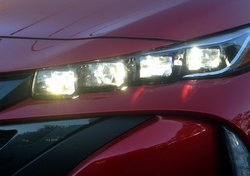
wind noise could be hidden a bit better, but the engine in gasoline mode was quiet. Of course when running on electricity only, there is no engine noise because no engine is running. Seems obvious, but it needed to be said.
The 15-inch alloy wheels and 195/65R tires delivers handling that was direct with little body roll. Nothing sporty about the Prius Prime in handling or acceleration, which was about 0–60 in 10 seconds. Being fair to Toyota, the Prius Prime is not marketed as a sporty car, but one that delivers a safe, secure and competent ride with outstanding fuel economy. No alternative facts here…Toyota delivered what they promised.
The previously mentioned regenerative braking system has four-wheel disc brakes with ABS. The stops were straight and true, with no brake fade, nor the sometimes noticeable hybrid braking whine.
Driving Experience: Interior
Clean Fleet Report was driving the Premium model, which is the middle trim level between Plus and Advanced. This gave us Toyota’s SofTex trimmed seats, which is a synthetic material designed for long wear, which is soft to the touch, resists spills and is easy to clean. And for the vegans out there, there are no animal-based materials used in the SofTex manufacturing process.
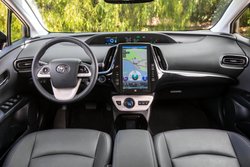
The 2017 Prius Prime only seats two in the rear seat. No big deal unless you need the third seat, at which point you will opt for one of the other three Prius models. For four adults though, the Prime’s interior is roomy with good head and leg room, and a center fold down armrest with cup holders.
The eight-way power-adjustable driver seat and the tilt/telescopic steering wheel made finding a comfortable driving position easy. The steering wheel has all the usual control buttons (audio, phone, cruise control, Bluetooth, etc.), and the ability to switch between fuel and battery (hybrid) gauges.
About those gauges. They are in the center of the dash with none, as in zero, being directly in front of the driver. It does not take much effort to look ten degrees to the right at all times, but it is odd. Maybe a heads-up display would be a nice addition.
The car has good front sightlines with a large windshield. Glancing in the mirror reveals the spoiler cutting horizontally midway through the rear window, a rear window that has a curved surface. A note to Toyota that we were not fans of a loud beeper going off inside the cabin when shifting into reverse. It seemed redundant and unnecessary because, as the driver, you know when the car is in reverse as the Rearview Camera pops-up on the screen and there is an obvious “R†on the dash. Plus, the beeping is not heard outside the car where it would be the most useful.
The Prius Prime came with Toyota’s Entune Premium Audio system with navigation and an 11.6-inch high-resolution touch-screen color display. This large vertical display is also found as on Toyota’s Mirai fuel cell vehicle. The six speaker system included an AM/FM cache radio with MP3/WMA playback capability, SiriusXM (which includes 90-day trial subscription) and HD AM Radio with iTunes. Also included are an auxiliary audio jack, USB port with iPod connectivity and control, hands-free phone, advanced voice recognition, Siri Eyes Free and music streaming via Bluetooth. The sound system does not have knobs for volume and channel selection, an annoying omission that must be designed to make the dash seem smooth and modern.
Driving Experience: Exterior
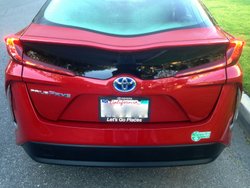
Redesigned and renamed for 2017, the Prius Prime is one of the most recognizable vehicles on the road. Most agree the front end design is fine, but opinions differ—strongly—about the rear end. The overall wedge-shape of the five-door hatchback has not changed much since introduced in 2003. (The first Prius models were introduced in 1997 as four-door sedans.) The shape is driven completely to reduce wind resistance and drag to increase fuel economy. Toyota says it “looks like the future†with the design “purely intentional.â€
The front end is dominated by two large air scoops on each corner of the lower fascia, topped by attractive rectangular quad-LED projector headlamps. The deeply sloped hood leads to a raked windshield and roof that peaks at the B pillar, and then drastically slopes all the way to the integrated spoiler on the rear hatch. The glass on the hatch has a dual wave design, which makes it unique. The hatch is made of carbon fiber, so it feels light at first touch but is solid when closing.
Now to the rear end. It is best to let you absorb and take it in to find your comfort zone.
Pricing
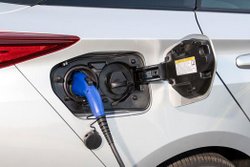
The 2017 Prius Prime comes in three trim levels—Plus, Premium and Advanced. Clean Fleet Report drove the Premium version, which will probably be the most popular considering its deep list of standard features.
The Prius Prime qualifies for Federal and State tax credits that could reduce your final cost. Clean Fleet Report recommends contacting your CPA before considering a Prius Prime purchase so you are completely clear on the tax credits. Not relying on the dealer to provide this information will serve them and you best.
Also worth noting is that in California the Prius Prime qualifies for the coveted car pool stickers allowing the driver, with no passenger, to use the HOV lane. This is no small thing when trying to get anywhere on a freeway in the Golden State. Make sure to check with your DMV to see if this benefit is available in your state.
These MSRPs do not include the $865 delivery, processing and handling fee.
Prime Plus                      $27,100
Prime Premium               $28,800
Prime Advanced             $33,100
Safety and Warranties
The 2017 Prius Prime is well-equipped for safety with remote keyless entry, push button start/stop, power door locks, heated and power outside mirrors, tire pressure monitoring system, seven airbags, vehicle stability and traction control, brake assist, engine immobilizer and full stop technology. Advanced driver pre-collision technology includes lane departure alert, dynamic radar cruise control and pedestrian detection.
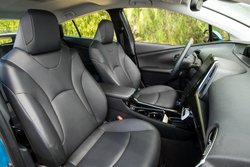
The 2017 Prius comes with these warranties:
- Basic – Three years/36,000 miles
- Powertrain – Five years/60,000 miles
- Rust-through – Five years/Unlimited miles
- Hybrid-related components (CA, MA, NY, NJ, VT, CT, ME, NM and RI) – 15 years/150,000 miles
- Battery (same states) – 10 years/150,000 miles
- Battery (remaining states) – Eight years/100,000 miles
- Toyota Care – Complimentary maintenance plan for two years/25,000 miles (for every new Toyota purchase or lease)
Observations: 2017 Toyota Prius Prime
The 133 MPGe EPA rating takes Toyota into a new competitive space of high-mileage alternative fuel vehicles. The smooth operation and seamless transition between gasoline and electric modes, the excellent interior fit and finish, and the drive/ride attributes of the Prius Prime make it a serious contender for anyone looking at a midsize car—regardless of its power source.
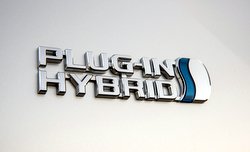
You will pay more for a hybrid versus a gasoline-powered car and more for a Prius Prime over a non-plug-in Prius. Is it worth it? If you drive most of your miles in town or in rush hour traffic, then you will benefit greatly from the pure electric mode of the Prime.
The proven reliability of the Prius line-up gives confidence that this car will be in your garage for many, many years.
Whatever you end up buying, enjoy your new car and as always, Happy Driving!
Related Stories You Might Enjoy:
Road Test: 2017 Ford Fusion Energi
Road Test: 2017 Chevrolet Volt
Comparison Test: 2017 Kia Optima Hybrid and Plug-in Hybrid
Road Test: 2017 Hyundai Sonata Plug-in Hybrid
Road Test: 2016 Toyota Prius
Road Test: 2016 Toyota Prius
First Drive: 2017 Kia Niro Hybrid
Comparison Test: 2014 Toyota Prius and Prius Plug-in
Road Test: 2014 Toyota Prius C and V
Disclosure:
Clean Fleet Report is loaned free test vehicles from automakers to evaluate, typically for a week at a time. Our road tests are based on this one-week drive of a new vehicle. Because of this we don’t address issues such as long-term reliability or total cost of ownership. In addition we are often invited to manufacturer events highlighting new vehicles or technology. As part of these events we may be offered free transportation, lodging or meals. We do our best to present our unvarnished evaluations of vehicles and news irrespective of these inducements.
Our focus is on vehicles that offer the best fuel economy in their class. We also feature those that are among the top mpg vehicles in their class. In addition, we aim to offer reviews and news on advanced technology and the alternative fuel vehicle market. We welcome any feedback from vehicle owners and are dedicated to providing a forum for alternative viewpoints. Please let us know your views at publisher@cleanfleetreport.com.

It is important to check what rebates are available on the Prius Prime where you live. In Colorado for example there is a $4500 federal tax credit and $5000 state rebate. This knocks almost 1/3 off the price for most buyers and makes the net cost of the Prime less than a “regular” Prius!
@BoulderHybrids Good advice. Also note that the state rebates can change at any time (for instance, California’s ran out of money).